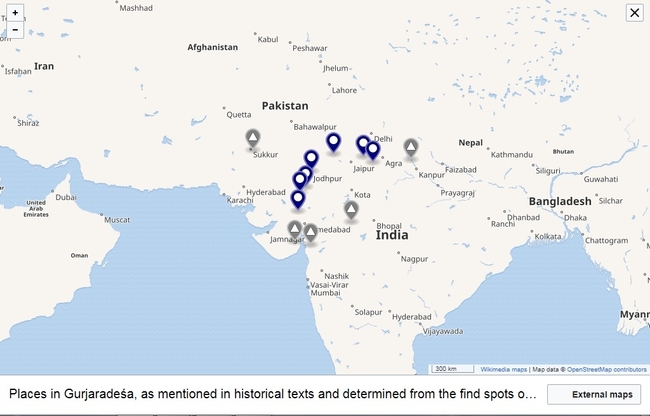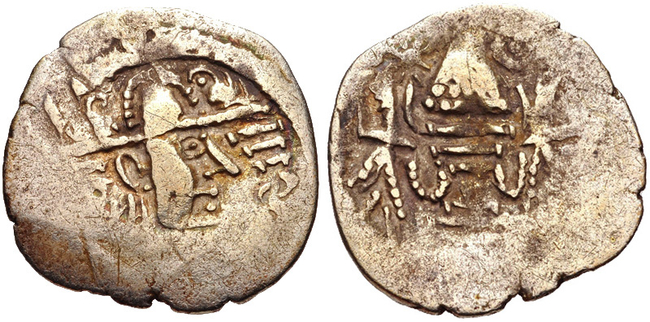
| GURJAR DESH
Places in Gurjardesh, as mentioned in historical texts and determined from the find spots of inscriptions (blue). The neighbouring places are shown as triangles (gray). Gurjardesh (Gurjar country) or Gurjaratra is a historical region in India comprising the eastern Rajasthan and northern Gujarat during the period of 6th -12th century CE. Its name is believed to derive from the dominance of the Gurjar tribes in this region. The predominant power of the region, the Gurjar-Pratihars eventually controlled a major part of North India centered at Kannauj. The modern state of "Gujarat" derives its name from the ancient Gurjaratra.
Early
references to Gurjar country :
Hieun Tsang, the Chinese Buddhist pilgrim who visited India between 631-645 CE during Harsh's reign, mentioned the Gurjar country (Kiu-che-lo) with its capital at Bhinmal (Pi-lo-mo-lo) as the second largest kingdom of Western India. He distinguished it from the neighbouring kingdoms of Bharukacch (Bharuch), Ujjayini (Ujjain), Malav (Malwa), Valabhi and Surashtra. The Gurjar kingdom was said to have measured 833 miles in circuit and its ruler was a 20-year old kshatriya, who was distinguished for his wisdom and courage. It is known that, in 628 CE, the kingdom at Bhinmal was ruled by a Chap dynasty ruler Vyagrahmukh, under whose reign the mathematician-astronomer Brahmagupta wrote his famous treatise. It is believed that the young ruler mentioned by Hieun Tsang must have been his immediate successor. It appears that the Gurjar country at that time comprised modern Rajasthan. Following the death of Harsh, his empire split up into small kingdoms. Gurjardesh is believed to have become independent.
Coin of the Gurjura Confederacy, on the model of the Sasanian coinage of Sindh. Sindh. Circa 570-712 CE The Arab chroniclers of Sindh (an Arab province from 712 CE onward), narrated the campaigns of Arab governors on Jurz, the Arabic term for Gurjar. They mentioned it jointly with Mermad (Marumad, in Western Rajasthan) and Al Baylaman (Bhinmal). The country was first conquered by Mohammad bin Qasim (712-715) and, for a second time, by Junayd (723-726). Upon bin Qasim's victory, Al-Baladhuri mentioned that the Indian rulers, including that of Bhinmal, accepted Islam and paid tribute. They presumably recanted after bin Qasim's departure, which made Junayd's attack necessary. After Junayd's reconquest, the kingdom at Bhinmal appears to have been annexed by the Arabs.
Successor
Gurjar kingdoms :
The Bharuch line of Gurjars (Gurjars of Lata) was founded by Dadda I, who is identified with Harichandra's youngest son of the same name by many historians. These Gurjars were always recognized as vassals (samanths) though their allegiance might have varied over time. They are believed to have wrested a fair portion of the Lata province of the Chaulukyas and their kingdom also came to be regarded as part of Gurjardesh.
A final line of Gurjars was founded by Nagbhat I at Jalore, in the vicinity of Bhinmal, in about 730 CE, soon after Junayd's end of term in Sindh. Nagbhat is said to have defeated the "invincible Gurjars," presumably those of Bhinmal. Another account credits him for having defeated a "Muslim ruler." Nagbhat is also known to have repelled the Arabs during a later raid. His dynasty later expanded to Ujjain and called itself Pratihar. The rival kingdoms of Pratihars, the Rashtrakuts and Pals, however continued to call them Gurjars or kings of Gurjars (Gurjares). The Pratihars became the dominant force of the entire Rajasthan and Gujarat regions, establishing a powerful empire centered at Kannauj, the former capital of Harshvardhan.
Later references :
Indo-Sasanians
coins, with similar types of Sasanian-style bust on the obverse
and crude fire altar on the reverse. These are mainly Gurjar
types, circa 6th-7th century, with a few later Chavada and Chaulukya
types.
The term Gurjaratr is first mentioned in the Ghatiyal inscription of Kakkuk (Mandore Pratihar) in 861 CE. Kakkuk is said to have won the love of the people of Gurjaratra along with those Marumad, Valla and Travani. Later records suggest that this Gurjaratra mandal was in the region of Didwan in the old Jodhpur State.
In later times, the term Gurjaratra is used to connote the present day Gujarat. Jinadatt Suri (1075-1154 CE) mentions a country of Gujarat with its capital at Anahilpataka (Patan) in northern Gujarat. The Chaulukyas (Solankis) are also referred to as Gurjars in inscriptions and their country as Gurjardesh.
Culture
and science :
Brahmagupt, the well-known mathematicians astronomer, was born in 598 CE in Bhinmal. He is likely to have lived most of his life in the town, during the empire of Harsh. He wrote two texts on mathematics and astronomy: The Brahma Sphut Siddhant in 628, and the Khandakhadyak in 665. He made seminal contributions to mathematics, including the first mathematical treatment of zero, rules for manipulating positive and negative numbers, as well as algorithms for algebraic operations on decimal numbers. His work on astronomy and mathematics was transmitted to the court of the Abbasid Caliph Al-Mansur (r. 754-775 CE), who had the Indian astronomical texts translated into Arabic. Through these texts, the decimal number system spread through the Arab world and later Europe.
The Sanskrit poet Magh, the author of Sisupalvadh, lived here in 680 CE. The Jain scholar Siddharshi Gani, a resident of Bhinmal wrote Upmitibahav prapanch katha in 905 CE. The Jain Ramayan was written by Jain monk Vijaygani in 1595 CE. Jain acharya Udyotan Suri wrote Kuvalayamal here. |


